java考试题库第六章.docx
JAVA第六章习题
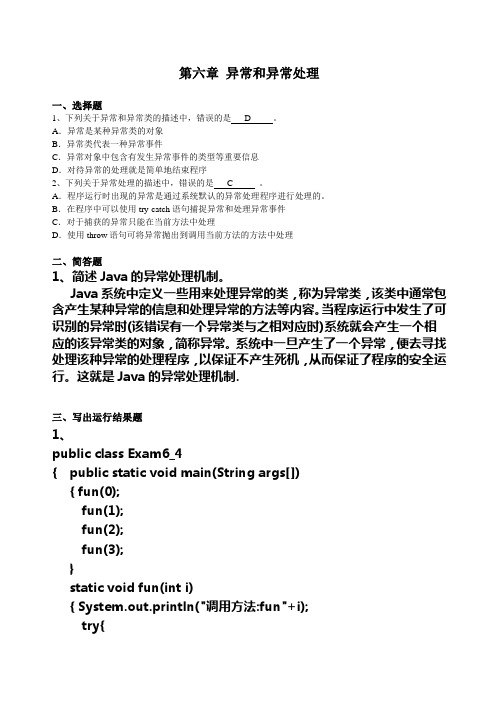
第六章异常和异常处理一、选择题1、下列关于异常和异常类的描述中,错误的是 D 。
A.异常是某种异常类的对象B.异常类代表一种异常事件C.异常对象中包含有发生异常事件的类型等重要信息D.对待异常的处理就是简单地结束程序2、下列关于异常处理的描述中,错误的是 C 。
A.程序运行时出现的异常是通过系统默认的异常处理程序进行处理的。
B.在程序中可以使用try-catch语句捕捉异常和处理异常事件C.对于捕获的异常只能在当前方法中处理D.使用throw语句可将异常抛出到调用当前方法的方法中处理二、简答题1、简述Java的异常处理机制。
Java系统中定义一些用来处理异常的类,称为异常类,该类中通常包含产生某种异常的信息和处理异常的方法等内容。
当程序运行中发生了可识别的异常时(该错误有一个异常类与之相对应时)系统就会产生一个相应的该异常类的对象,简称异常。
系统中一旦产生了一个异常,便去寻找处理该种异常的处理程序,以保证不产生死机,从而保证了程序的安全运行。
这就是Java的异常处理机制.三、写出运行结果题1、public class Exam6_4{ public static void main(String args[]){ fun(0);fun(1);fun(2);fun(3);}static void fun(int i){ System.out.println("调用方法:fun"+i);try{if(i==0) System.out.println("没有异常");else if(i==1){int a=0; int b=10; b/=a;}else if(i==2){int m[]=new int[5]; m[5]=100;}else if(i==3){String str="56k9"; intn=Integer.parseInt(str);}}catch(ArithmeticException e){System.out.println("捕捉异常:"+e.getMessage());} catch(ArrayIndexOutOfBoundsException e){System.out.println("捕捉异常:"+e);}catch(NumberFormatException e){System.out.println("捕捉异常:"+e);}finally{System.out.println("处理完毕! ");}}}2、public class Exam6_5{ public static void main(String args[]){ try{fun1();}catch(ArithmeticException e){System.out.println("捕捉异常:"+e.getMessage());} try{fun2( );}catch(ArrayIndexOutOfBoundsException e){System.out.println("捕捉异常:"+e);}finally {System.out.println("处理完毕! ");}}static void fun1() throws ArithmeticException{ System.out.println("调用方法:fun1");int a=0; int b=10; b/=a;throw new ArithmeticException();}static void fun2() throws ArrayIndexOutOfBoundsException { System.out.println("调用方法:fun2");int m[]=new int[5]; m[5]=100;throw new ArrayIndexOutOfBoundsException();}}。
java答案第六章
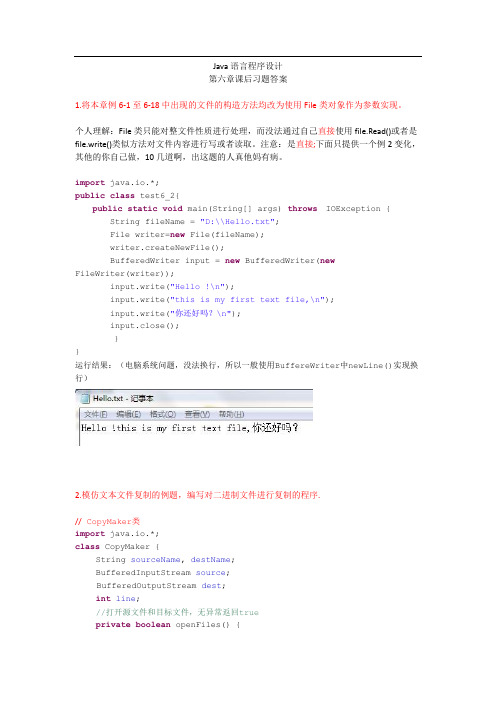
Java语言程序设计第六章课后习题答案1.将本章例6-1至6-18中出现的文件的构造方法均改为使用File类对象作为参数实现。
个人理解:File类只能对整文件性质进行处理,而没法通过自己直接使用file.Read()或者是file.write()类似方法对文件内容进行写或者读取。
注意:是直接;下面只提供一个例2变化,其他的你自己做,10几道啊,出这题的人真他妈有病。
import java.io.*;public class test6_2{public static void main(String[] args) throws IOException { String fileName = "D:\\Hello.txt";File writer=new File(fileName);writer.createNewFile();BufferedWriter input = new BufferedWriter(newFileWriter(writer));input.write("Hello !\n");input.write("this is my first text file,\n");input.write("你还好吗?\n");input.close();}}运行结果:(电脑系统问题,没法换行,所以一般使用BuffereWriter中newLine()实现换行)2.模仿文本文件复制的例题,编写对二进制文件进行复制的程序.// CopyMaker类import java.io.*;class CopyMaker {String sourceName, destName;BufferedInputStream source;BufferedOutputStream dest;int line;//打开源文件和目标文件,无异常返回trueprivate boolean openFiles() {try {source = new BufferedInputStream(newFileInputStream( sourceName ));}catch ( IOException iox ) {System.out.println("Problem opening " + sourceName );return false;}try {dest = new BufferedOutputStream(newFileOutputStream( destName ));}catch ( IOException iox ){System.out.println("Problem opening " + destName );return false;}return true;}//复制文件private boolean copyFiles() {try {line = source.read();while ( line != -1 ) {dest.write(line);line = source.read();}}catch ( IOException iox ) {System.out.println("Problem reading or writing" );return false;}return true;}//关闭源文件和目标文件private boolean closeFiles() {boolean retVal=true;try { source.close(); }catch ( IOException iox ) {System.out.println("Problem closing " + sourceName );retVal = false;}try { dest.close(); }catch ( IOException iox ) {System.out.println("Problem closing " + destName );retVal = false;}return retVal;}//执行复制public boolean copy(String src, String dst ) {sourceName = src ;destName = dst ;return openFiles() && copyFiles() && closeFiles();}}//test6_2public class test6_2{public static void main ( String[] args ) {String s1="lin.txt",s2="newlin.txt";if(new CopyMaker().copy(s1, s2))S ystem.out.print("复制成功");elseS ystem.out.print("复制失败");}}运行前的两个文本:lin.txt和newlin.txt(为空)运行后:3.创建一存储若干随机整数的文本文件,文件名、整数的个数及范围均由键盘输入。
《Java语言程序设计:基础篇》课后复习题答案-第六章

《Java语言程序设计:基础篇》课后复习题答案-第六章Chapter6Single-dimensional Arrays1.See the section"Declaring and Creating Arrays."2.You access an array using its index.3.No memory is allocated when an array is declared.The memory is allocated whencreating the array.x is60The size of numbers is304.Indicate true or false for the following statements:1.Every element in an array has the same type.Answer:True2.The array size is fixed after it is declared.Answer:False3.The array size is fixed after it is created.Answer:True4.The element in the array must be of primitive data type.Answer:False5.Which of the following statements are valid array declarations?int i=new int(30);Answer:Invaliddouble d[]=new double[30];Answer:Validchar[]r=new char(1..30);Answer:Invalidint i[]=(3,4,3,2);Answer:Invalidfloat f[]={2.3, 4.5, 5.6};Answer:Validchar[]c=new char();Answer:Invalid6.The array index type is int and its lowest index is0.a[2]7.(a)double[]list=new double[10];(b)list[list.length–1]=5.5;(c)System.out.println(list[0]+list[1]);(d)double sum=0;for(int i=0;i<list.length;i++)< p="">sum+=list[i];(e)double min=list[0];for(int i=1;i<list.length;i++)< p="">if(min>list[i])min=list[i];(f)System.out.println(list[(int)(Math.random()*list.length));(g)double[]={3.5, 5.5, 4.52, 5.6};8.A runtime exception occurs.9.Line3:the array declaration is wrong.It should be double[].The array needs tobe created before its been used.e.g.new double[10]Line5:The semicolon(;)at the end of the for loop heading should be removed.Line5:r.length()should be r.length.Line6:random should be random()Line6:r(i)should be r[i].10.System.arraycopy(source,0,t,0,source.length);11.The second assignment statement myList=new int[20]creates a new array andassigns its reference to myList.myList new int[10]Array myList new int[10]Arraynew int[20]Array12.False.When an array is passed to a method,the reference value of the array ispassed.No new array is created.Both argument and parameter point to the samearray.13.numbers is 0and numbers[0]is314.(A) ExecutingcreateArray in Line 6Space required for the main methodchar[] chars: refHeap Array of 100 charactersSpace required for the createArray methodchar[] chars: ref(B) After exitingcreateArray in Line 6Space required for themain methodchar[] chars: refHeapArray of 100charactersStack Stack (C) ExecutingdisplayArray in Line 10Space required for the main methodchar[] chars: refHeap Array of 100 charactersSpace required for the displayArray method char[] chars: ref(D) After exitingdisplayArray in Line10Space required for themain methodchar[] chars: refHeapArray of 100charactersStack Stack(E) Executing countLetters in Line 13 Space required for the main methodint[] counts: refchar[] chars: refHeap Array of 100 charactersSpace required for the countLetters method int[] counts: refchar[] chars: ref (F) After exitingcountLetters in Line 13Space required for themain methodint[] counts: refchar[] chars: refHeapArray of 100charactersStack StackArray of 26 integers Array of 26 integers(G) Executing displayCounts in Line 18Space required for the main methodint[] counts: refchar[] chars: refHeap Array of 100 charactersSpace required for the displayCounts methodint[] counts: ref (H) After exitingdisplayCounts in Line 18Space required for themain methodint[] counts: refchar[] chars: refHeapArray of 100charactersStack StackArray of 26 integers Array of 26 integers15.Only one variable-length parameter may be specified ina method and this parameter must be the last parameter.The method return type cannot be a variable-length parameter.16.The last oneprintMax(new int[]{1,2,3});is incorrect,because the array must of the double[] type.17.Omitted18.Omitted19.Omitted20Simply change(currentMaxlist[j])21Simply change list[k]>currentElement on Line9tolist[k]<currentelement< p="">22.You can sort an array of any primitive types except boolean.The sort method is void,so it does not return a new array.23.To apply java.util.Arrays.binarySearch(array,key),the array must be sorted in increasing order.24.Line1:list is{2,4,7,10}Line2:list is{7,7,7,7}Line3:list is{7,8,8,7}Line4:list is{7,8,8,7}</currentelement<></list.length;i++)<></list.length;i++)<>。
自考JAVA语言程序设计(一)课后习题答案与源代码(第六章)
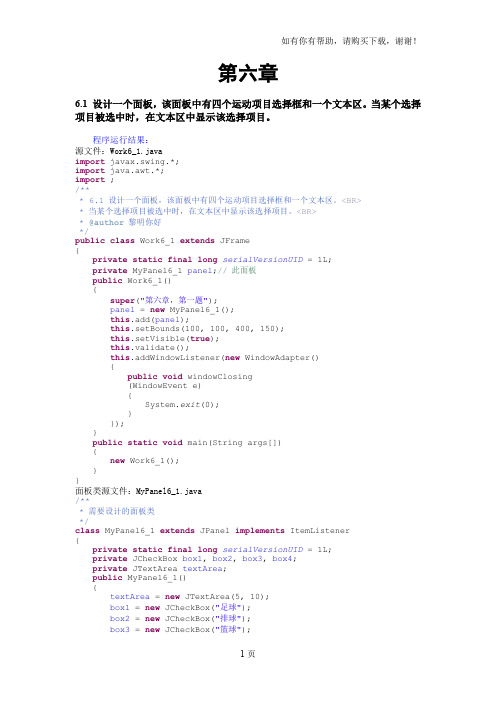
第六章6.1 设计一个面板,该面板中有四个运动项目选择框和一个文本区。
当某个选择项目被选中时,在文本区中显示该选择项目。
程序运行结果:源文件:Work6_1.javaimport javax.swing.*;import java.awt.*;import ;/*** 6.1设计一个面板,该面板中有四个运动项目选择框和一个文本区。
<BR>*当某个选择项目被选中时,在文本区中显示该选择项目。
<BR>*@author黎明你好*/public class Work6_1 extends JFrame{private static final long serialVersionUID = 1L;private MyPanel6_1 panel;// 此面板public Work6_1(){super("第六章,第一题");panel = new MyPanel6_1();this.add(panel);this.setBounds(100, 100, 400, 150);this.setVisible(true);this.validate();this.addWindowListener(new WindowAdapter(){public void windowClosing(WindowEvent e){System.exit(0);}});}public static void main(String args[]){new Work6_1();}}面板类源文件:MyPanel6_1.java/***需要设计的面板类*/class MyPanel6_1 extends JPanel implements ItemListener{private static final long serialVersionUID = 1L;private JCheckBox box1, box2, box3, box4;private JTextArea textArea;public MyPanel6_1(){textArea = new JTextArea(5, 10);box1 = new JCheckBox("足球");box2 = new JCheckBox("排球");box3 = new JCheckBox("篮球");box4 = new JCheckBox("台球");box1.addItemListener(this);box2.addItemListener(this);box3.addItemListener(this);box4.addItemListener(this);this.add(box1);this.add(box2);this.add(box3);this.add(box4);this.add(textArea);this.setBackground(Color.cyan);}public void itemStateChanged(ItemEvent e){JCheckBox box = (JCheckBox) e.getSource();if (box == box1 && box.isSelected())textArea.append(box1.getText() + "\n");else if (box == box2 && box.isSelected())textArea.append(box2.getText() + "\n");else if (box == box3 && box.isSelected())textArea.append(box3.getText() + "\n");else if (box == box4 && box.isSelected())textArea.append(box4.getText() + "\n");}}6.2 设计一个面板,该面板中有四个运动项目单选框和一个文本框。
JAVA考试题库第六章
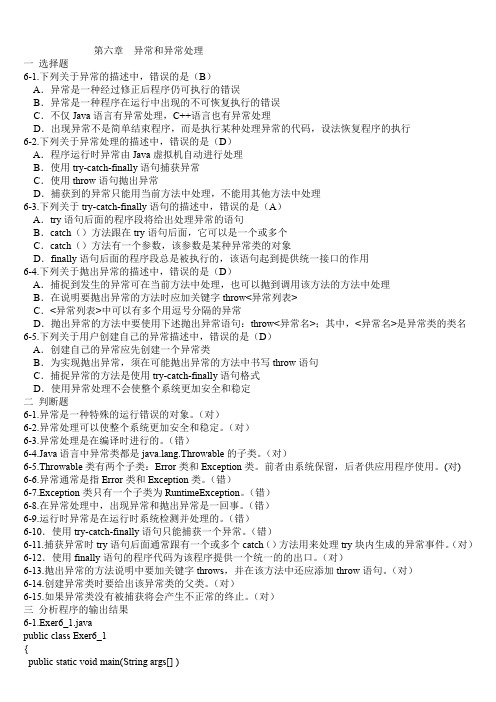
二 判断题
6-1.异常是一种特殊的运行错误的对象。(对) 6-2.异常处理可以使整个系统更加安全和稳定。(对) 6-3.异常处理是在编译时进行的。(错) 6-4.Java 语言中异常类都是 ng.Throwable 的子类。(对) 6-5.Throwable 类有两个子类:Error 类和 Exception 类。前者由系统保留,后者供应用程序使用。(对) 6-6.异常通常是指 Error 类和 Exception 类。(错) 6-7.Exception 类只有一个子类为 RuntimeException。(错) 6-8.在异常处理中,出现异常和抛出异常是一回事。(错) 6-9.运行时异常是在运行时系统检测并处理的。(错) 6-10.使用 try-catch-finally 语句只能捕获一个异常。(错) 6-11.捕获异常时 try 语句后面通常跟有一个或多个 catch()方法用来处理 try 块内生成的异常事件。(对) 6-12.使用 finally 语句的程序代码为该程序提供一个统一的的出口。(对) 6-13.抛出异常的方法说明中要加关键字 throws,并在该方法中还应添加 throw 语句。(对) 6-14.创建异常类时要给出该异常类的父类。(对) 6-15.如果异常类没有被捕获将会产生不正常的终止。(对) 三 分析程序的输出结果
6-1.Exer6_1.java public class Exer6_1 { public static void main(String args[] )
Java实战经典(第六章课后题答案)
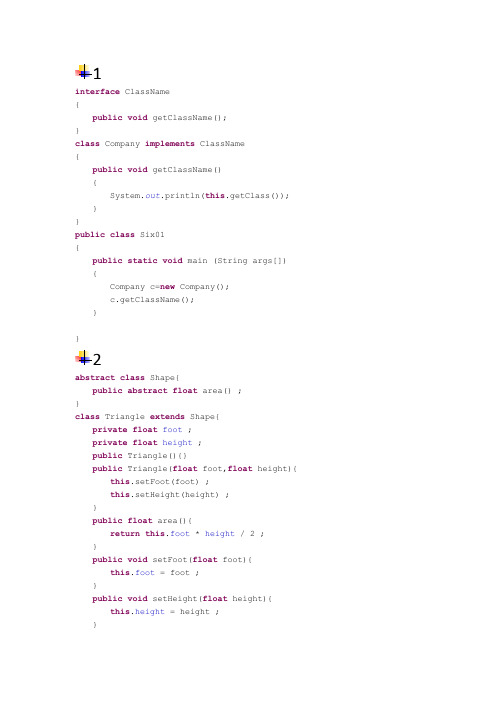
public float getFoot(){ return this.foot ;
} public float getHeight(){
return this.height ; } } class Cycle extends Shape{ private float radius ; private static final float PI = 3.1415926f ; public Cycle(){} public Cycle(float radius){
4
《Java程序设计案例教程》第六章练习答案
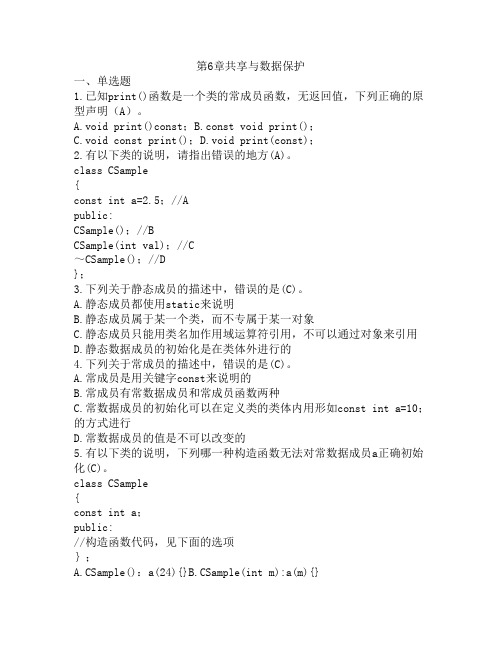
第6章共享与数据保护一、单选题1.已知print()函数是一个类的常成员函数,无返回值,下列正确的原型声明(A)。
A.void print()const;B.const void print();C.void const print();D.void print(const);2.有以下类的说明,请指出错误的地方(A)。
class CSample{const int a=2.5;//Apublic:CSample();//BCSample(int val);//C~CSample();//D};3.下列关于静态成员的描述中,错误的是(C)。
A.静态成员都使用static来说明B.静态成员属于某一个类,而不专属于某一对象C.静态成员只能用类名加作用域运算符引用,不可以通过对象来引用D.静态数据成员的初始化是在类体外进行的4.下列关于常成员的描述中,错误的是(C)。
A.常成员是用关键字const来说明的B.常成员有常数据成员和常成员函数两种C.常数据成员的初始化可以在定义类的类体内用形如const int a=10;的方式进行D.常数据成员的值是不可以改变的5.有以下类的说明,下列哪一种构造函数无法对常数据成员a正确初始化(C)。
class CSample{const int a;public://构造函数代码,见下面的选项};A.CSample():a(24){}B.CSample(int m):a(m){}C.CSample(){a=24;}D.CSample(int m):a(m+24){}6.设类AA内定义了一个int型的静态数据成员a,下列哪种方式对a的初始化正确(D)。
A.在类AA的定义体内用static int a=20;B.在类AA的定义体外单独用语句static int a=20 ;C.在类AA的定义体外单独用语句static int AA∷a=20;D.在类AA的定义体外单独用语句int AA∷a=20;7.关于静态成员函数,下列说法不正确的是(A)。
java(教学0)韩建雷6练习题第六章.doc
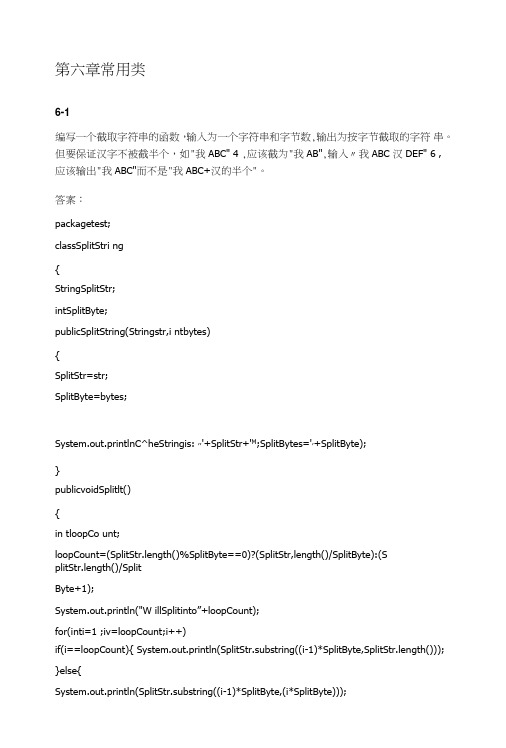
第六章常用类6-1编写一个截取字符串的函数,输入为一个字符串和字节数,输出为按字节截取的字符串。
但要保证汉字不被截半个,如"我ABC" 4 ,应该截为"我AB",输入〃我ABC 汉DEF" 6 ,应该输出"我ABC"而不是"我ABC+汉的半个"。
答案:packagetest;classSplitStri ng{StringSplitStr;intSplitByte;publicSplitString(Stringstr,i ntbytes){SplitStr=str;SplitByte=bytes;System.out.printlnC^heStringis: ,,'+SplitStr+'M;SplitBytes=',+SplitByte);}publicvoidSplitlt(){in tloopCo unt;loopCount=(SplitStr.length()%SplitByte==0)?(SplitStr,length()/SplitByte):(SplitStr.length()/SplitByte+1);System.out.println("W il lSplitinto”+loopCount);for(inti=1 ;iv=loopCount;i++)if(i==loopCount){ System.out.println(SplitStr.substring((i-1)*SplitByte,SplitStr.length())); }else{System.out.println(SplitStr.substring((i-1)*SplitByte,(i*SplitByte)));}}publicstaticvoidmai n(Strin g[]args){SplitStringss=newSplitString(H test 中dd 文dsaf 中男大3443n 中国43 中国人0ewldfls=103n,4);ss.Splitlt();}}6-2使用String类的public String concat(String str)方法可以把调用该方法的字符串与参数指定的字符串连接,把str指定的串连接到当前串的尾部获得一个新的串。
JAVA语言程序设计基础课后习题第六章
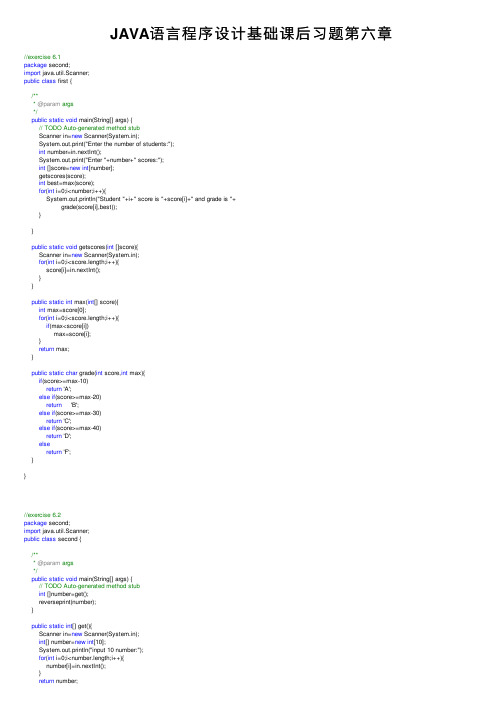
JAVA语⾔程序设计基础课后习题第六章//exercise 6.1package second;import java.util.Scanner;public class first {/*** @param args*/public static void main(String[] args) {// TODO Auto-generated method stubScanner in=new Scanner(System.in);System.out.print("Enter the number of students:");int number=in.nextInt();System.out.print("Enter "+number+" scores:");int []score=new int[number];getscores(score);int best=max(score);for(int i=0;i<number;i++){System.out.println("Student "+i+" score is "+score[i]+" and grade is "+grade(score[i],best));}}public static void getscores(int []score){Scanner in=new Scanner(System.in);for(int i=0;i<score.length;i++){score[i]=in.nextInt();}}public static int max(int[] score){int max=score[0];for(int i=0;i<score.length;i++){if(max<score[i])max=score[i];}return max;}public static char grade(int score,int max){if(score>=max-10)return 'A';else if(score>=max-20)return 'B';else if(score>=max-30)return 'C';else if(score>=max-40)return 'D';elsereturn 'F';}}//exercise 6.2package second;import java.util.Scanner;public class second {/*** @param args*/public static void main(String[] args) {// TODO Auto-generated method stubint []number=get();reverseprint(number);}public static int[] get(){Scanner in=new Scanner(System.in);int[] number=new int[10];System.out.println("input 10 number:");for(int i=0;i<number.length;i++){number[i]=in.nextInt();}return number;}public static void reverseprint(int[]Array){for(int i=Array.length-1;i>=0;i--){System.out.print(Array[i]+" ");}}}//exercise 6.3package second;import java.util.Scanner;public class third {/*** @param args*/public static void main(String[] args) {// TODO Auto-generated method stubScanner in=new Scanner(System.in);int[] newarray=new int[100];int temp;for(int i=0;i<newarray.length;i++){newarray[i]=0;}System.out.print("Enter the integers between 1 and 100:");while((temp=in.nextInt())!=0){newarray[temp]++;}resultprint(newarray);}public static void resultprint(int []array){for(int i=0;i<array.length;i++){if(array[i]==1)System.out.println(i+" occurs "+array[i]+" time");if(array[i]!=0&&array[i]!=1)System.out.println(i+" occurs "+array[i]+" times");}}}//exercise 6-4package first;import java.util.Scanner;public class first {/*** @param args*/public static void main(String[] args) {// TODO Auto-generated method stubScanner in=new Scanner(System.in);int []score=new int[100];int i=0,sum=0,count=0;System.out.print("input integer:");while((score[i]=in.nextInt())!=-1){sum+=score[i++];count++;}int average=sum/count;int big=0,small=0;for(int j=0;j<count;j++){if(score[j]<average)small++;elsebig++;}System.out.println("average is "+average);System.out.println("better than average is "+big);System.out.println("small than average is "+small);}}//exercise 6-5package first;import java.util.Scanner;public class second {/*** @param args*/public static void main(String[] args) {// TODO Auto-generated method stub Scanner in=new Scanner(System.in); System.out.print("Enter ten numbers:");int []integer=new int[10];int count=0;for(int i=0;i<10;i++){boolean judge=false;int temp=in.nextInt();for(int j=0;j<count;j++){if(temp==integer[j]){judge=true;}}if(!judge){integer[count++]=temp;}}System.out.print("input integer:");for(int i=0;i<count;i++){System.out.print(integer[i]+" ");}}}//exercise 6-7package first;public class third {/*** @param args*/public static void main(String[] args) {// TODO Auto-generated method stubint []counts=new int[10];for(int i=0;i<100;i++){int random=(int)(Math.random()*10); counts[random]++;}for(int i=0;i<10;i++){System.out.print(i+" ");}System.out.println();for(int i=0;i<10;i++){System.out.print(counts[i]+" ");}}}//exercise 6-8package first;public class fourth {/*** @param args*/public static int average(int[]array){int sum=0,count=0;for(int i=0;i<array.length;i++){sum+=array[i];count++;}return sum/count;}public static double average(double []array){double sum=0;int count=0;for(int i=0;i<array.length;i++){sum+=array[i];count++;}return sum/count;}}//exercise 6-9package first;public class fifth {/*** @param args*/public static double min(double []array){double min=array[0];for(int i=0;i<array.length;i++){if(min>array[i])min=array[i];}return min;}}//exercise 6-10package first;public class seventh {/*** @param args*/public static int indexOfSmallestElement(double[] array){ double min=array[0];for(int i=0;i<array.length;i++){if(min>array[i])min=array[i];}for(int i=0;i<array.length;i++){if(min==array[i])return i;}return 0;}}。
java题库整理
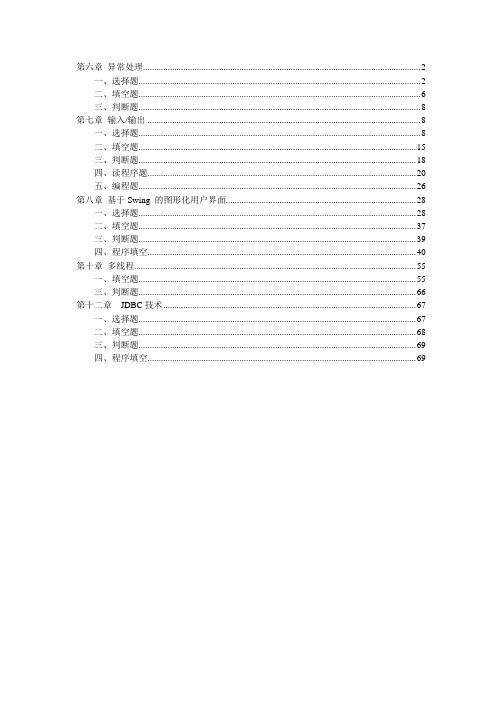
第六章异常处理 (2)一、选择题 (2)二、填空题 (6)三、判断题 (8)第七章输入/输出 (8)一、选择题 (8)二、填空题 (15)三、判断题 (18)四、读程序题 (20)五、编程题 (26)第八章基于Swing 的图形化用户界面 (28)一、选择题 (28)二、填空题 (37)三、判断题 (39)四、程序填空 (40)第十章多线程 (55)一、填空题 (55)三、判断题 (66)第十二章JDBC技术 (67)一、选择题 (67)二、填空题 (68)三、判断题 (69)四、程序填空 (69)第六章异常处理一、选择题1、无论是否发生异常,都需要执行()A、try语句块B、catch语句块C、finally语句块D、return语句答案:c2、异常处理变量()。
A、应用public关键字B、可以应用protected关键字C、可以应用private关键字D、只能在异常处理方法内使用。
答案:d3、通常的异常类是()A、ExceptionB、exceptionC、CommonExceptionD、ExceptionShare 答案:a4、异常产生的原因很多,常见的有()。
A、程序设计本身的错误B、程序运行环境改变C、软、硬件设置错误D、以上都是答案:a5、下列什么是除0异常()。
A、RuntimeExceptionB、ClassCastExceptionC、ArihmetticExceptionD、ArrayIndexOutOfBoundException答案:c6、读下面代码,哪个选项是正确的()import java.io.*;public class Test2{public static void main(String []args)throws IOException{i f(args[0]==”hello”)throw new IOException();}}A、没有错误,程序编译正确B、编译错误,不能够在main方法中抛出异常C、编译错误,IOException是一个系统异常,不能够由application程序产生D、没有输出结果答案:a7、当变异并且运行下面程序时会出现什么结果?()public class ThrowsDemo{static void throwMethod() {System.out.print("Inside throwMethod");throw new IOException("demo");}public static void main(String [] args){try{throwMethod();}catch(IOException e){System.out.println("Cauht"+e);}}}A、编译错误B、运行错误C、编译成功,但不会打印出任何结果D、没有输出结果答案:A8、执行下面程序的结果是什么?其中a=4,b=0 ()public static void divide(int a,int b){try{ int c = a / b; }catch(Exception e){System.out.println("Exception");}finally{System.out.println("Finally");}}A、打印Exception finallyB、打印FinallyC、打印ExceptionD、没有输出结果答案:A9、假定一个方法会产生非RuntimeException异常,如果希望把异常交给调用该方法的方法处理,正确的声明方式是什么?()A、throw ExceptionB、throws ExceptionC、new ExceptionD、不需要指明什么答案:B10、阅读下面的代码段、try{tryThis();return;}catch(IOException x1){System.out.println(“exception 1”);Return;}catch(Exception x2){System.out.println(“exception 1”);Return;}finally{System.out.println(“finally”)}如果tryThis()抛出一个IOException,那么屏幕的输出是什么?()A、”exception 1”后面跟着”finally”B、” exception 2”后面跟着“finally”C、”exception 1”D、”exception 2””答案:A11、下列哪些内容不是异常的含义?()A、程序的语法错B、程序编译或运行中所发生的异常事件C、程序预先定义好的异常事件D、程序编译错误答案:A12、自定义的异常类可从下列哪个类继承?()A、Error类B、AWTErrorC、VirtualMachineErrorD、Exception及其子集答案:D13、当方法遇到异常又不知如何处理时,下列哪种做法是正确的?()A、捕获异常B、抛出异常C、声明异常D、嵌套异常答案:B14、如要抛出异常,应用下列哪种子句?()A、catchB、throwC、tryD、finally答案:B15、下列选项中属于Exception异常的是()A、ArithmeticExceptionB、nullPointerExceptionC、classcastExceptionD、以上都是答案:A16、以下是异常的处理,哪个选项是正确的()A、book()throws exceptionB、book(int a)exceptionC、book()throwsD、book()throw exception答案:A17、将需要处理异常作为()语句块的一个参数来进行声明A、tryB、catchC、finallyD、以上都不对答案:B18、try语句块可以()A、拥有惟一的一个catch语句块B、多个finally语句块C、一个或多个catch语句块D、以上答案都不对答案:C19、下列什么是所有Exception和Error类的共同超类()A、ThrowableB、CheckedExceptionC、CatchableD、RuntimeException答案:A20、假定一个方法可能会产生非RuntimeException异常,如果希望把异常交给调用该方法的方法处理,正确的声明方式是()A、throws ExceptionB、throw ExceptionC、new ExceptionD、不需要指明什么答案:A21、try代码块中包含的是可能引起一个或多个异常代码,能够抛出异常的代码必须位于()代码块中。
Java基础第6章编程题答案

第六章集合编程题1.遍历一个LinkedList集合,写一个可以删除所有与“tom”相同的元素的静态方法。
(集合中的元素自行添加)注意:不要使用for循环遍历删除,会出现删除不干净的情况【参考答案】import java.util.ArrayList;import java.util.Iterator;import java.util.LinkedList;public class Test {public static void main(String[] args) {LinkedList<String> list=new LinkedList<String>();list.add("tom");list.add("jack");list.add("jone");list.add("tom");System.out.println(list);removes(list,"tom");System.out.println(list);}public static void removes(LinkedList<String> list, String s) {Iterator iterator = list.iterator();while (iterator.hasNext()) {String str = (String) iterator.next();if (str.equals(s)) {iterator.remove();}}}}2.如何判断两个集合是否有交集,并打印出他们的交集提示:判断这两个集合是否包含相同的对象或元素,可以使用retainAll方法:oldCourses.retainAll(newCoures)。
如果存在相同元素,oldCourses中仅保留相同的元素。
java测试试卷(六)答案
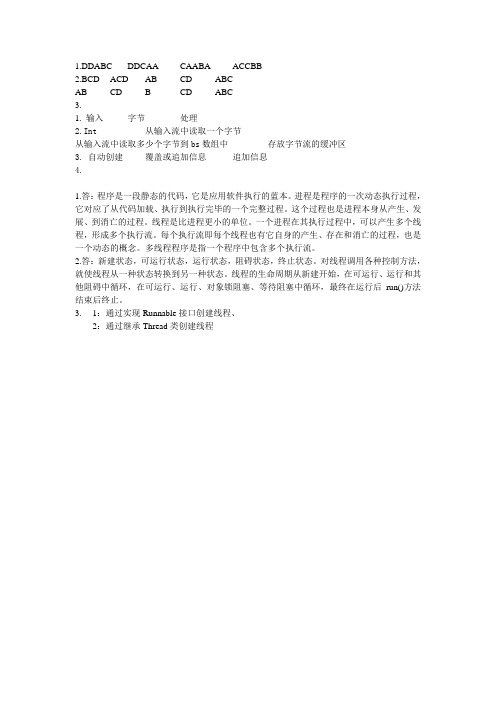
1.DDABC DDCAA CAABA ACCBB
2.BCD ACD AB CD ABC
AB CD B CD ABC
3.
1.输入字节处理
2.Int 从输入流中读取一个字节
从输入流中读取多少个字节到bs数组中存放字节流的缓冲区
3. 自动创建覆盖或追加信息追加信息
4.
1.答:程序是一段静态的代码,它是应用软件执行的蓝本。
进程是程序的一次动态执行过程,它对应了从代码加载、执行到执行完毕的一个完整过程。
这个过程也是进程本身从产生、发展、到消亡的过程。
线程是比进程更小的单位。
一个进程在其执行过程中,可以产生多个线程,形成多个执行流。
每个执行流即每个线程也有它自身的产生、存在和消亡的过程,也是一个动态的概念。
多线程程序是指一个程序中包含多个执行流。
2.答:新建状态,可运行状态,运行状态,阻碍状态,终止状态。
对线程调用各种控制方法,就使线程从一种状态转换到另一种状态。
线程的生命周期从新建开始,在可运行、运行和其他阻碍中循环,在可运行、运行、对象锁阻塞、等待阻塞中循环,最终在运行后run()方法结束后终止。
3. 1:通过实现Runnable接口创建线程、
2:通过继承Thread类创建线程。
JAVA期末复习题及答案——第六章
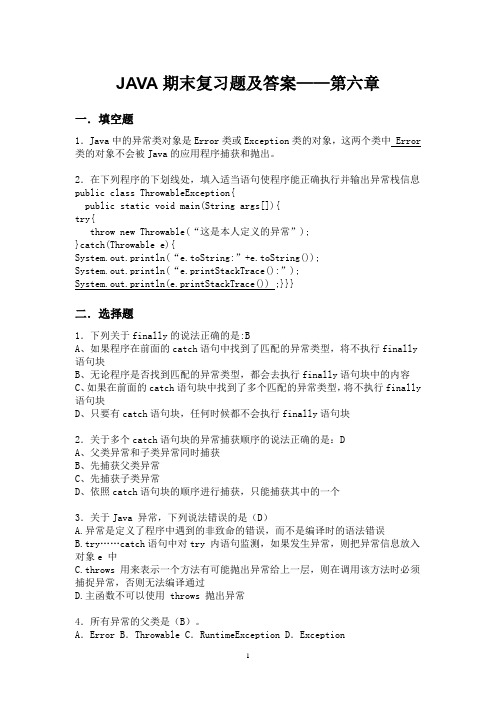
JAVA期末复习题及答案——第六章一.填空题1.Java中的异常类对象是Error类或Exception类的对象,这两个类中 Error 类的对象不会被Java的应用程序捕获和抛出。
2.在下列程序的下划线处,填入适当语句使程序能正确执行并输出异常栈信息public class ThrowableException{public static void main(String args[]){try{throw new Throwable(“这是本人定义的异常”);}catch(Throwable e){System.out.println(“e.toString:”+e.toString());System.out.println(“e.printStackTrace():”);System.out.println(e.printStackTrace()) ;}}}二.选择题1.下列关于finally的说法正确的是:BA、如果程序在前面的catch语句中找到了匹配的异常类型,将不执行finally 语句块B、无论程序是否找到匹配的异常类型,都会去执行finally语句块中的内容C、如果在前面的catch语句块中找到了多个匹配的异常类型,将不执行finally 语句块D、只要有catch语句块,任何时候都不会执行finally语句块2.关于多个catch语句块的异常捕获顺序的说法正确的是:DA、父类异常和子类异常同时捕获B、先捕获父类异常C、先捕获子类异常D、依照catch语句块的顺序进行捕获,只能捕获其中的一个3.关于Java 异常,下列说法错误的是(D)A.异常是定义了程序中遇到的非致命的错误,而不是编译时的语法错误B.try……catch语句中对try 内语句监测,如果发生异常,则把异常信息放入对象e 中C.throws 用来表示一个方法有可能抛出异常给上一层,则在调用该方法时必须捕捉异常,否则无法编译通过D.主函数不可以使用 throws 抛出异常4.所有异常的父类是(B)。
java chapter 6(带作业题)

• 程序第一次引用含有静态变量的类时,将静态变量 分配存储空间;
• 在方法中声明的局部变量不能具有静态属性。 • Java程序的main方法必须用static修饰符进行说明, 使解释器执行main方法时,不用实例化含main方 法的类。
8
• 6.4.2 同一个类的对象之间的依赖性 • 即一个类对象与本类的其他对象交互。要实现这一操作, 可以将一个类的对象作为一个参数传递给本类的一个方法, 使得该方法可以对作为参数得到的对象进行操作。 • 例如: str3 = str1.concat( str2) ;
例题 6.3 例题 6.4
9
• 6.4.3 聚合(has a )关系 • 一个聚合对象由其他的对象组成,形成一个”has a”关系 • 一个聚合对象的定义是:将其他对象的引用作为自己的实 例数据的对象。 • 聚合关系是依赖关系的特殊类型,即类A被类B定义为类B 的一部分时,类A便依赖类B,类B就是聚合类。 • 一个聚合类通常要调用其组成部分类的方法。 • 例题 6.5 • 例题 6.6 • 例题 6.7
14
• 6.5.1 Comparable接口 • 该接口定义在ng包中,该接口中只有一个方法 compareTo,该方法的参数是一个对象,返回值为整型值。 • Comparable接口的目的是提供对两个对象进行比较的通 用机制。 • 例如: • if (pareTo(obj2) < 0) • system.out.println (“obj1 is less than obj2”); • 6.5.2 Iterator接口 • 也定义在Java标准类库中,由代表一个对象结合的类使用, 主要提供了在一个对象集合中每操作一次移动到下一个对 象的方法。 • 该接口中的两个方法是hasNext和next方法。
Java语言程序设计(一)课后习题第六章(附答案)
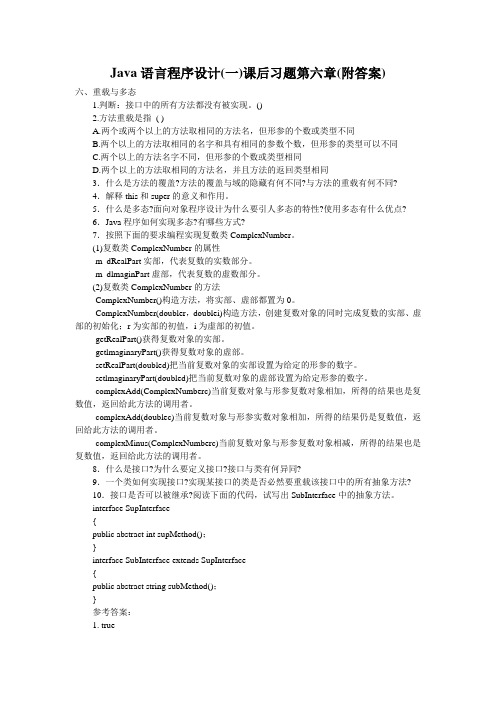
·getlmaginaryPart()获得复数对象的虚部。
·setRealPart(doubled)把当前复数对象的实部设置为给定的形参的数字。
·setlmaginaryPart(doubled)把当前复数对象的虚部设置为给定形参的数字。
·complexAdd(ComplexNumberc)当前复数对象与形参复数对象相加,所得的结果也是复数值,返回给此方法的调用者。
+ cNumber_2.toString() + “等于“
+ cNumber_plexMinus(cNumber_2).toString());
System.out.println(cNumber_1.toString() + “减“
+ d + “等于“
+ cNumber_plexMinus(d).toString());
System.out.println(cNumber_1.toString() + “乘“
+ cNumber_2.toString() + “等于“
+ cNumber_plexMulti(cNumber_2).toString());
System.out.println(cNumber_1.toString() + “乘“
{
public abstract string subMethod();
}
参考答案:
1. trueLeabharlann 2.A3.答:子类重新定义父类中已经存在的方法,称为方法的覆盖。注意:方法覆盖与域的隐藏不同。子类重新定义父类已有的域,并不能完全取代它从父类那里继承的同名的域,这个域仍然占用子类的内存空间,在某些情况下会被使用;而当子类重新定义父类的方法时,从父类那里继承来的方法将被新方法完全取代,不再在子类的内存空间中占一席之地。与方法的覆盖不同,重载不是子类对父类同名方法的重新定义,而是在一个类中定义了同名的不同方法。
计算机二级JAVA-6
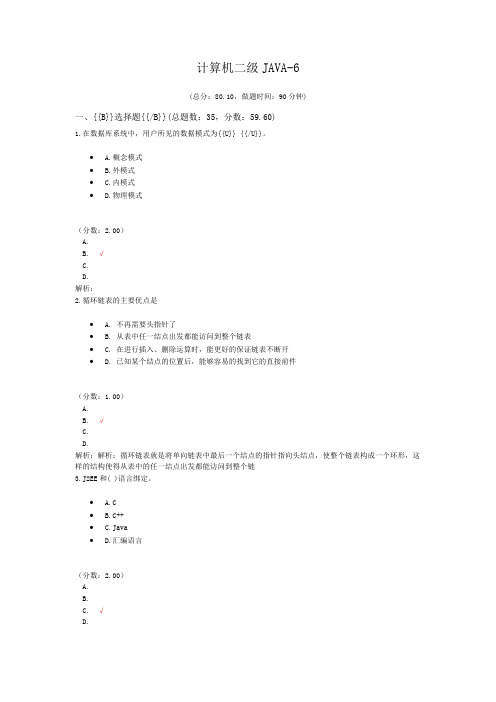
计算机二级JAVA-6(总分:80.10,做题时间:90分钟)一、{{B}}选择题{{/B}}(总题数:35,分数:59.60)1.在数据库系统中,用户所见的数据模式为{{U}} {{/U}}。
∙ A.概念模式∙ B.外模式∙ C.内模式∙ D.物理模式(分数:2.00)A.B. √C.D.解析:2.循环链表的主要优点是∙ A. 不再需要头指针了∙ B. 从表中任一结点出发都能访问到整个链表∙ C. 在进行插入、删除运算时,能更好的保证链表不断开∙ D. 已知某个结点的位置后,能够容易的找到它的直接前件(分数:1.00)A.B. √C.D.解析:解析:循环链表就是将单向链表中最后一个结点的指针指向头结点,使整个链表构成一个环形,这样的结构使得从表中的任一结点出发都能访问到整个链3.J2EE和( )语言绑定。
∙ A.C∙ B.C++∙ C.Java∙ D.汇编语言(分数:2.00)A.B.C. √D.解析:[解析] J2EE的基础是J2SE,以Java为平台;而C语言用于ODBCAPI。
由于两者不兼容,SUN公司才提出了JDBC作为Java几个平台与数据库的标准连接。
4.在下列程序的空白处,应填入的正确选项是{{U}} {{/U}}。
importjava.io.*;PublicclasswriteInt{Publicstaticvoidmain(stringl)a){Int[]myArray={10,20,30,40};try{DataOutputSystemdos=newDataOutputSystem(newFileOu中utSystem(“ints.dat”));for (int i=0;I<MYARRAY.LENGTH:I++)dos.writeInt(myArray[i];dos.______";System.out.println(“Havewritten binary flleints.dat”);}Catch(IOExceptiOniOe){System.out.println(“IOException”);}}}∙ A.start()∙ B.Close()∙ C.read()∙ D.write()(分数:2.00)A.B. √C.D.解析:[解析] close方法关闭写文件。
(完整word版)《JAVA语言程序设计》期末考试试题及答案6(应考必备题库)
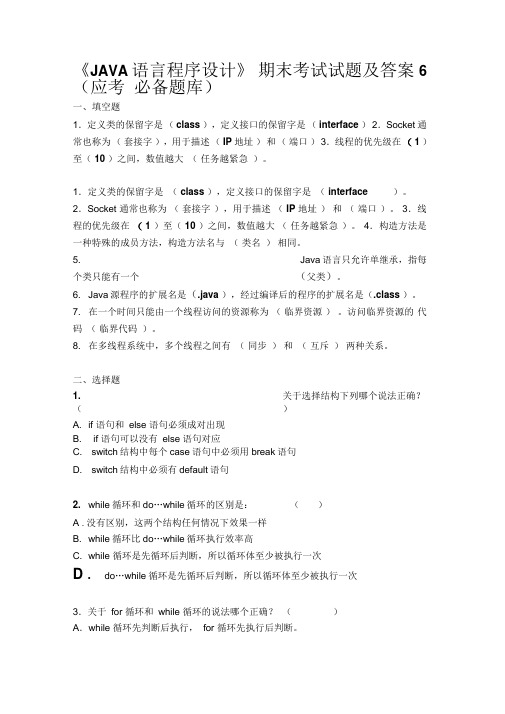
《JAVA 语言程序设计》期末考试试题及答案6(应考必备题库)一、填空题1.定义类的保留字是(class ),定义接口的保留字是(interface ) 2.Socket 通常也称为(套接字),用于描述(IP 地址)和(端口) 3.线程的优先级在( 1 )至(10 )之间,数值越大(任务越紧急)。
1.定义类的保留字是(class ),定义接口的保留字是(interface )。
2.Socket 通常也称为(套接字),用于描述(IP 地址)和(端口)。
3.线程的优先级在( 1 )至(10 )之间,数值越大(任务越紧急)。
4.构造方法是一种特殊的成员方法,构造方法名与(类名)相同。
5. Java语言只允许单继承,指每个类只能有一个(父类)。
6. Java源程序的扩展名是(.java ),经过编译后的程序的扩展名是(.class )。
7. 在一个时间只能由一个线程访问的资源称为(临界资源)。
访问临界资源的代码(临界代码)。
8. 在多线程系统中,多个线程之间有(同步)和(互斥)两种关系。
二、选择题1. 关于选择结构下列哪个说法正确?()A. if 语句和else 语句必须成对出现B. if 语句可以没有else 语句对应C. switch结构中每个case语句中必须用break语句D. switch结构中必须有default语句2. while循环和do…while循环的区别是:()A .没有区别,这两个结构任何情况下效果一样B. while循环比do…while循环执行效率高C. while 循环是先循环后判断,所以循环体至少被执行一次D . do…while循环是先循环后判断,所以循环体至少被执行一次3.关于for 循环和while 循环的说法哪个正确?()A.while 循环先判断后执行,for 循环先执行后判断。
B.while 循环判断条件一般是程序结果,for 循环的判断条件一般是非程序结果C •两种循环任何时候都不可以替换D. 两种循环结构中都必须有循环体,循环体不能为空4.下列修饰符中与访问控制无关的是()A. private C. protected B.public D.final5. void 的含义:( )A.方法没有返回值B.方法体为空C.没有意义D. 定义方法时必须使用6 .return 语句:( )A .只能让方法返回数值B.方法都必须含有C .方法中可以有多句return D.不能用来返回对象7.关于对象成员占用内存的说法哪个正确?()A•同一个类的对象共用同一段内存B、同一个类的对象使用不同的内存段,但静态成员共享相同的内存空间C •对象的方法不占用内存D.以上都不对8.下列说法哪个正确?A .不需要定义类,就能创建对象B. 对象中必须有属性和方法C. 属性可以是简单变量,也可以是一个对象D. 属性必须是简单变量9.下列说法哪个正确?()A、一个程序可以包含多个源文件B、一个源文件中只能有一个类C、一个源文件中可以有多个公共类D、一个源文件只能供一个程序使用10.关于方法ma in ()的说法哪个正确?(A •方法main ()只能放在公共类中B ma in()的头定义可以根据情况任意更改C • 一个类中可以没有main()方法D .所有对象的创建都必须放在 mai n()方法中11.构造函数何时被调用? ( )A 、创建对象时c 、使用对象的方法时12. 抽象方法: ( )A 、 可以有方法体B 、 可以出现在非抽象类中C 、是没有方法体的方法D 、抽象类中的方法都是抽象方法13.关于继承的说法正确的是: ( )A 、 子类将继承父类所有的属性和方法。
- 1、下载文档前请自行甄别文档内容的完整性,平台不提供额外的编辑、内容补充、找答案等附加服务。
- 2、"仅部分预览"的文档,不可在线预览部分如存在完整性等问题,可反馈申请退款(可完整预览的文档不适用该条件!)。
- 3、如文档侵犯您的权益,请联系客服反馈,我们会尽快为您处理(人工客服工作时间:9:00-18:30)。
第六章异常和异常处理一选择题6・1 .下列关于异常的描述中,错误的是(B)A.异常是一种经过修正后程序仍可执行的错误B.异常是一种程序在运行中出现的不可恢复执行的错误C.不仅Java语言有异常处理,C++语言也有异常处理D.岀现异常不是简单结束程序,而是执行某种处理异常的代码,设法恢复程序的执行6・2.下列关于异常处理的描述中,错误的是(D)A.程序运行时异常由Java虚拟机自动进行处理B.使用try-catch-finally语句捕获异常C.使用throw语句抛出异常D.捕获到的异常只能用当前方法中处理,不能用其他方法中处理6・3.下列关于try-catch-finally语句的描述中,错误的是(A)A・try语句后面的程序段将给出处理异常的语句B・catch ()方法跟在try语句后面,它可以是一个或多个C. catch ()方法有一个参数,该参数是某种异常类的对彖D・finally语句后面的程序段总是被执行的,该语句起到提供统一接口的作用6・4.下列关于抛出异常的描述中,错误的是(D)A.捕捉到发牛的异常可在当前方法中处理,也可以抛到调用该方法的方法中处理B.在说明要抛出异常的方法吋应加关键字throw<异常列表〉C.v异常列表〉中可以有多个用逗号分隔的异常D.抛岀异常的方法中要使用下述抛出异常语句:throw<异常名〉;其中,v异常名>是异常类的类名6・5.下列关于用户创建自己的异常描述中,错误的是(D)A.创建自己的异常应先创建一个异常类B.为实现抛出异常,须在可能抛出异常的方法中书写throw语句C.捕捉异常的方法是使用try-catch-finally语句格式D.使用异常处理不会使整个系统更加安全和稳定二判断题6・1 .异常是一种特殊的运行错误的对象。
(对)62异常处理可以使整个系统更加安全和稳定。
(对)6・3.异常处理是在编译时进行的。
(错)6-4.Java语言中异常类都是ng.Throwable的子类。
(对)6-5.Throwable类有两个子类:Enor类和Exception类。
前者由系统保留,后者供应用程序使用。
(对)6・6.异常通常是指Error类和Exception类。
(错)6-7.Exception 类只有一个子类为RuntimeException o(错)68在异常处理屮,出现异常和抛出异常是一回事。
(错)6・9.运行时异常是在运行时系统检测并处理的。
(错)6-10.使用try-catch-finally语句只能捕获一个异常。
(错)6・11 •捕获异常时try语句后面通常跟有一个或多个catch ()方法用来处理try块内牛成的异常事件。
(对)6・12・使用finally语句的程序代码为该程序提供一个统一的的出口。
(对)6・13.抛出异常的方法说明中要加关键字throws,并在该方法屮还应添加throw语句。
(对)6・14.创建异常类时要给出该异常类的父类。
(对)6J5.如果异常类没有被捕获将会产生不正常的终止。
(对)三分析程序的输出结果6・1. Exer6_l.javapublic class Exer6_lpublic static void main(String args[])int x=10,y=0;int z=x/y;System.out.println(u z="+z);}}该程序运行后,输岀结果如图所示:D:\JAVA\XT>java Exer6_lException in thread"main^ng.ArithmeticException:/by zero At Exer6_l .main<Exer6_l .java:6>6・ 2.Exer6_2.javapublic class Exer6_2{public static void main(String args[]){int array 1[]={ 6,0,8};for(int i=0;i<array 1 .length;i++){try{int d=100/array[i];System.out.println( ^\t 正常:d= "+d);} catch(ArithmeticException e){System.out.println("\t 算术异常”);} catch(ArrayIndexOutOfBoundsException e){System.out.println("\t 下标越界异常”);}finally{System.out.println("\t 异常处理结束! \n H);运行该程序后,输出如图所示D:\JAVA\XT>java Exer6_2 正常:d二16 界常处理结束!算术异常!异常处理结束!正常:d=12异常处理结束!下标越界异常!异常处理结束!6-3 Exer6_3.javapublic class Exer6_3{public static void main(String args[]){ 〜int array 1[]={ 6,0,8}; for(int i=0;i<=array 1 .length;i++) {try{int d=100/arrayl[i]; System.out.println("\t 正常:d二"+d);1 catch(RuntimeException e) { ”System.out.println("\t 异常':"+e.toString());} finally{System.out.println(H\t 异常处理结束! \n n); }}运行该程序后,输岀结果如图所示:D:\JAVA\XT>java Exer6_3 正常:d=16 界常处理结朿!异常:ng.ArilhmeticException:/by zero 异常处理结束!正常:d=12异常处理结束!异常:ng.ArrayIndexOutOfBoundsExcepiton:3 异常处理结束!6-4 Exer6_4.javapublic class Exer6_4{public static void Test(){int a[]=new int[3];for(int i=O;i<=a.length;i++){try{a[i]=i+5;System.out.println("\t 正常:a["+i+n]=,'+a[i]); }catch(ArrayIndexOutOfBoundsException e){System.out.println(H\t 异常:+e.toString()H); throw e;public static void main(String args[]){try{Test();}finally{System.out.println("\t 异常处理结束! \n H)}}运行该程序后,输岀结果如图:D:\JAVA\XT>java Exer6_4正常:alO]=5正常:a[l]=6正常:a[2]=7异常:javaJang.AmiylndexOulOfBoudsExceplion: 3 异常处理结束!Exception in thread "main9 ng.AiTayIndexOutOfBoundsExcepiton:3 at Exer6_4.Test<Exer6_4.java: 1()> at Exer6_4.main<Exer6_4java:24>6-5 Exer6_5.javaclass myException extends Exception{static int a=0myException(String s){super(s); a++;}String show(){return11自定义异常出现的次数:”+a;}}Public class Exer6_5{static void Test() throws myException{myException e;e=new myException(H自定义异常\n”); throw e;}Public static void main(String argsfl){for(int i=0;iv3;i++){try{Test();1catch(myException e){System.out.println(e.show());System.out.println(e.toString);运行该程序后,输岀结果如图所示:D:\JAVA\XT>java Exer6_5 自定义异常出现的次数:1 myException:自定义异常自定义异常出现的次数:2 myException: 口定义异常自定义异常出现的次数:3 my Exception:自定义界常5.简单回答题6-1检测异常事件必须使用什么语句?答:try语句6-2 catch()方法的作用是什么?该方法用户能否调用?答:用来处理try块中检测出的异常事件。
6-3 catch()方法中异常类型应与什么相符?答:与生成的异常事件类型相符。
6-4异常示被捕获到将会出现什么现象?答:try语句后边的惯常处理代码将不被执行,通常使用finally语句提供一个统一出口。
6-5在一个try语句的程序代码块中可以捕获多个异常吗?答:可以6-6使用throw语句抛出的是类型还是对象?答:抛出的是对象。
6-7捕获到的异常还可以再抛出吗?答:可以。
6-8 Finally语句块中的代码何时被执行?答:在异常事件处理的方法catch()执行后执行。
6-9语句throw的作用是什么?答:抛出所检测到的异常。
6-10 异常类Exception的父类是什么?答:是Throwable 类。
6.编程题6-1编程实现下述异常,并输出显示适当的错误信息。
(1)数组卜标越界异常ArraylndexOutOfBoundsException类型。
例如,char ch[]=new char[5];ch[5]=W;〃产生该类型异常(2)对象转换异常ClassCastException类型。
例如,将对象al转换为对象a2时,如果al和a2不是同类,并且al也不是a2 的子类对彖时,则产生该类型异常。
(3)引用空对象的变量和方法时产生NullPointerException异常类型。
例如,int arf]=null;System.out.println (ar.length);〃产生该类异常(1)关于数组下标越界异常ArraylndexOutOfBoundsException请参照本书本章例6.1的程序,请读者自行编写。
